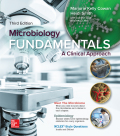
Microbiology Fundamentals: A Clinical Approach
3rd Edition
ISBN: 9781260163698
Author: Cowan
Publisher: MCG
expand_more
expand_more
format_list_bulleted
Question
Chapter 11.2, Problem 11AYP
Summary Introduction
To determine:
A definition of virulence factors.
Concept introduction:
Microorganisms that cause disease are termed as pathogens or the infectious causative agents. When a pathogen invades the tissue of an individual it will lead to create infections. Infectious agent which has the ability to cause disease is called pathogenicity and the rate to which an infectious agent is pathogenic is termed as virulence.
Expert Solution & Answer
Want to see the full answer?
Check out a sample textbook solution
Students have asked these similar questions
Give only the mode of inheritance consistent with all three pedigrees and only two reasons that support this, nothing more, (it shouldn't take too long)
O
Describe the principle of homeostasis.
Chapter 11 Solutions
Microbiology Fundamentals: A Clinical Approach
Ch. 11.1 - Prob. 1AYPCh. 11.1 - Enumerate the sites where normal biota is found in...Ch. 11.1 - Discuss how the Human Microbiome Project is...Ch. 11.1 - Prob. 2NPCh. 11.2 - Differentiate between a microbes pathogenicity and...Ch. 11.2 - Prob. 5AYPCh. 11.2 - Explain the significance of polymicrobial...Ch. 11.2 - Prob. 7AYPCh. 11.2 - Prob. 8AYPCh. 11.2 - Prob. 9AYP
Ch. 11.2 - Prob. 10AYPCh. 11.2 - Prob. 11AYPCh. 11.2 - Draw a diagram of the stages of disease in a humanCh. 11.2 - Prob. 13AYPCh. 11.2 - Prob. 14AYPCh. 11.2 - Define healthcare-associated infection, and list...Ch. 11.2 - Prob. 16AYPCh. 11.2 - Prob. 1MMCh. 11.2 - Prob. 3NPCh. 11.2 - Prob. 2MMCh. 11.2 - Prob. 4NPCh. 11.2 - Prob. 5NPCh. 11.2 - Q. Can you think of what type of incident might...Ch. 11.2 - Prob. 6NPCh. 11.3 - Summarize the goals of epidemiology, and...Ch. 11.3 - Prob. 18AYPCh. 11.3 - Prob. 19AYPCh. 11.3 - Discuss the three major types of epidemics, and...Ch. 11 - Prob. 1NPCh. 11 - Prob. 1QCh. 11 - Prob. 2QCh. 11 - Prob. 3QCh. 11 - Prob. 4QCh. 11 - Prob. 5QCh. 11 - Discuss the role of endospores in ensuring the...Ch. 11 - Prob. 7QCh. 11 - Correlate the stages in the course of an...Ch. 11 - Prob. 9QCh. 11 - Prob. 10QCh. 11 - Prob. 11QCh. 11 - Prob. 12QCh. 11 - Prob. 13QCh. 11 - Prob. 14QCh. 11 - Prob. 15QCh. 11 - Prob. 16QCh. 11 - Prob. 17QCh. 11 - Prob. 18QCh. 11 - The number of cases, including new cases as well...Ch. 11 - Prob. 20QCh. 11 - One important way to critically analyze a study...Ch. 11 - Prob. 1VC
Knowledge Booster
Learn more about
Need a deep-dive on the concept behind this application? Look no further. Learn more about this topic, biology and related others by exploring similar questions and additional content below.Similar questions
- Explain how the hormones of the glands listed below travel around the body to target organs and tissues : Pituitary gland Hypothalamus Thyroid Parathyroid Adrenal Pineal Pancreas(islets of langerhans) Gonads (testes and ovaries) Placentaarrow_forwardWhat are the functions of the hormones produced in the glands listed below: Pituitary gland Hypothalamus Thyroid Parathyroid Adrenal Pineal Pancreas(islets of langerhans) Gonads (testes and ovaries) Placentaarrow_forwardDescribe the hormones produced in the glands listed below: Pituitary gland Hypothalamus Thyroid Parathyroid Adrenal Pineal Pancreas(islets of langerhans) Gonads (testes and ovaries) Placentaarrow_forward
- Please help me calculate drug dosage from the following information: Patient weight: 35 pounds, so 15.9 kilograms (got this by dividing 35 pounds by 2.2 kilograms) Drug dose: 0.05mg/kg Drug concentration: 2mg/mLarrow_forwardA 25-year-old woman presents to the emergency department with a 2-day history of fever, chills, severe headache, and confusion. She recently returned from a trip to sub-Saharan Africa, where she did not take malaria prophylaxis. On examination, she is febrile (39.8°C/103.6°F) and hypotensive. Laboratory studies reveal hemoglobin of 8.0 g/dL, platelet count of 50,000/μL, and evidence of hemoglobinuria. A peripheral blood smear shows ring forms and banana-shaped gametocytes. Which of the following Plasmodium species is most likely responsible for her severe symptoms? A. Plasmodium vivax B. Plasmodium ovale C. Plasmodium malariae D. Plasmodium falciparumarrow_forwardStandard Concentration (caffeine) mg/L Absorbance Reading 10 0.322 20 0.697 40 1.535 60 2.520 80 3.100arrow_forward
- please draw in the answers, thank youarrow_forwarda. On this first grid, assume that the DNA and RNA templates are read left to right. DNA DNA mRNA codon tRNA anticodon polypeptide _strand strand C с A T G A U G C A TRP b. Now do this AGAIN assuming that the DNA and RNA templates are read right to left. DNA DNA strand strand C mRNA codon tRNA anticodon polypeptide 0 A T G A U G с A TRParrow_forwardplease answer all question below with the following answer choice, thank you!arrow_forward
arrow_back_ios
SEE MORE QUESTIONS
arrow_forward_ios
Recommended textbooks for you
 Comprehensive Medical Assisting: Administrative a...NursingISBN:9781305964792Author:Wilburta Q. Lindh, Carol D. Tamparo, Barbara M. Dahl, Julie Morris, Cindy CorreaPublisher:Cengage LearningHealth Safety And Nutrition F/Young ChildHealth & NutritionISBN:9781305144767Author:MAROTZPublisher:Cengage
Comprehensive Medical Assisting: Administrative a...NursingISBN:9781305964792Author:Wilburta Q. Lindh, Carol D. Tamparo, Barbara M. Dahl, Julie Morris, Cindy CorreaPublisher:Cengage LearningHealth Safety And Nutrition F/Young ChildHealth & NutritionISBN:9781305144767Author:MAROTZPublisher:Cengage- Case Studies In Health Information ManagementBiologyISBN:9781337676908Author:SCHNERINGPublisher:Cengage

Comprehensive Medical Assisting: Administrative a...
Nursing
ISBN:9781305964792
Author:Wilburta Q. Lindh, Carol D. Tamparo, Barbara M. Dahl, Julie Morris, Cindy Correa
Publisher:Cengage Learning


Health Safety And Nutrition F/Young Child
Health & Nutrition
ISBN:9781305144767
Author:MAROTZ
Publisher:Cengage


Case Studies In Health Information Management
Biology
ISBN:9781337676908
Author:SCHNERING
Publisher:Cengage

Infectious Diseases - How do we control them?; Author: Let's Learn Public Health;https://www.youtube.com/watch?v=2JWku3Kjpq0;License: Standard Youtube License